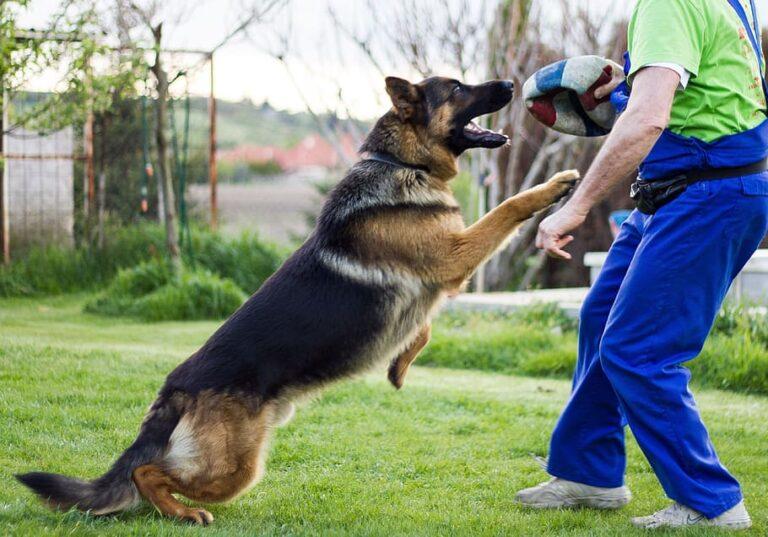Will a bark collar teach my dog to stop barking? Dog Collar Secrets

Will a bark collar teach my dog to stop barking?
Every dog has its own story to tell through barks, and there’s no one-size-fits-all answer to the question, “Will a bark collar teach my dog to stop barking?” Our furry friends come in all shapes and sizes, each with their quirks and personalities. This means that their reasons for barking, the frequency, and the duration can vary widely. So, the effectiveness of a bark collar isn’t a simple ‘yes’ or ‘no.’ It’s more like a personalized journey for each pup. Think of it this way: just like people react differently to consequences like fines or punishments, our dogs also have their unique responses to training methods. Some might quickly learn and adapt to the new rules, while others could take their time or show a bit of rebellion.
Comparing it to human experiences, dogs don’t have the same level of reasoning, but the principle of individual response still stands. Just as people have their own ways of dealing with situations, dogs will have their own take on bark collars. Each wagging tail represents a unique set of traits, likes, and dislikes. This diversity makes it essential to approach the idea of using a bark collar with an open mind. What works for one furry buddy might not work the same way for another. The journey toward quieter days might involve a little trial and error, but in the end, it’s about finding the approach that best fits your pup’s character and needs.
Will a bark collar teach my dog to stop barking? Explore some key points
Studies on the effectiveness of bark collars have yielded mixed results. While some dogs do show a reduction in barking after wearing the collars, the outcomes can vary based on factors such as the dog’s temperament, breed, and individual response to the collar’s stimuli. It’s important to recognize that even when bark collars seem to work initially, they might not address the underlying causes of barking, which can result in the behavior resurfacing once the collar is removed.
The key to successfully using a bark collar lies in understanding the specific needs of your dog. Some dogs may respond well to the collar and show a decrease in barking, while others might become anxious or fearful due to the collar’s stimuli. Furthermore, it’s essential to remember that training methods that prioritize positive reinforcement tend to be more sustainable and create a stronger bond between the dog and the owner.
Why Dogs Bark: The Story Behind Their Woofs
Have you ever wondered why dogs just can’t help but bark? Well, it’s not just random noise – it’s their unique way of talking to us and everyone else. Dogs bark for many reasons; first and foremost, it’s important for you to know why your dog barks. There can be several reasons behind it.
Let’s uncover the secrets of why our furry buddies love to woof and wag!
here are some key points on why dogs bark: Also read this:
- Communication: Barking is a way for dogs to communicate with humans and other animals.
- Alerts and Warnings: Dogs bark to alert their owners to potential dangers or intruders.
- Expressing Emotions: Barking can show excitement, happiness, fear, or frustration.
- Boredom or Loneliness: Dogs may bark when they’re bored or feeling isolated.
- Territorial Behavior: Barking marks their territory and warns others to stay away.
- Attention-Seeking: Some dogs bark to get attention from their owners.
- Responding to Other Dogs: Dogs often bark in response to the barking of other dogs.
- Anxiety and Stress: Barking can be a result of anxiety or stress.
- Health Issues: Pain or discomfort may cause dogs to bark.
- Playful Behavior: Dogs can bark during play to express enthusiasm.
How to properly train a dog with a bark collar?
Bark collar training can be a game-changer when it comes to curbing excessive barking in your furry companion. However, it’s essential to approach this method with care, ensuring both the effectiveness and the well-being of your dog. Here are ten crucial points to guide you in properly training your dog using a bark collar. By blending the power of technology with positive reinforcement, you can strike a balance that leads to a more harmonious relationship between you and your pup. Let’s delve into these key points to set you and your dog up for success.
- 1. Select the Right Collar
- 2. Introduce Gradually
- 3. Choose Appropriate Settings
- 4. Use Positive Reinforcement
- 5. Monitor Reaction
- 6. Consistency is Key
- 7. Avoid Overuse
- 8. Regular Check-ins
- 9. Reward Quiet Moments
- 10. Get expert advice
- 1. Select the Right Collar: Just like we wear shoes that fit well, your furry friend needs a collar that suits them. Consider their size, how they react to things, and what kind of collar might be comfy for them. Some collars are like a snug hug, while others might feel weird. Make sure it’s not too tight or too loose – find the one that fits just right.
- 2. Introduce Gradually: Think of it as getting used to a new friend. Before you jump into using the collar for training, let your dog hang out with it. You don’t want them to be surprised by sudden noises or vibrations. Let them wear the collar without any action for a bit. It’s like saying, “Hey, collar, meet my dog!”
- 3. Choose Appropriate Settings: Do you know how your TV remote controls the volume? Well, bark collars have settings too. Start with the lowest setting so it’s not too intense for your dog. Just like you don’t want the TV blaring, your pup doesn’t want to be buzzed too much. If they’re still going full-on Woofzilla, you can gradually increase the sensitivity – but not too much, okay?
- 4. Use Positive Reinforcement: Imagine if you got a high-five every time you did something cool. Dogs are like that too. When your pup stops barking or barks less, show them some love! Pat them gently and give them a treat. It’s like giving them a thumbs-up for being a good listener.
- 5. Monitor Reaction: Ever notice how some people don’t like spicy food, while others gulp down hot sauce like it’s nothing? Dogs are unique too. Keep an eye on how your dog reacts to the collar. Are they getting used to it? Do they seem calmer around things that used to make them bark? It’s like reading their body language to see how they’re feeling.
- 6. Consistency is Key: Think of it like a team sport. Everyone on the team needs to play by the same rules. If you and others are using the collar for training, make sure you’re all on the same page. Consistency helps your pup understand what’s expected, just like following the same game rules helps everyone know how to play.
- 7. Avoid Overuse: Bark collars are like your favorite snack – great once in a while, but not all day every day. Using it all the time might not be super comfy for your pup. They might start feeling like they’re being buzzed for no reason. Mix it up with other training methods and remember, it’s not a magic wand, but more like a helpful tool in your training toolbox.
- 8. Regular Check-ins: Think of it like checking your phone for messages. Keep an eye on how your dog is doing. Are they barking less often? Are they getting the message? Sometimes it’s like a puzzle – you’re putting pieces together to see the bigger picture. Adjust things as needed to help your pup get better at keeping the barks in check.
- 9. Reward Quiet Moments: Just like you’d get a thumbs-up for finishing your veggies, your dog deserves praise for not barking up a storm. When things are peaceful and quiet, let them know they’re doing awesome. A treat or a gentle pat can be like a “good job” badge for your fur buddy.
- 10. Seek Professional Guidance: Sometimes, we all need a little help from our friends. If you’re feeling unsure about using the bark collar or things aren’t going as planned, reach out to a dog trainer. They’re like experts who can offer advice and guidance tailored to your pup’s unique personality. It’s like having a coach for your pup’s training journey.
Do bark collars work on large dogs?
Bark collars for large dogs are designed to address excessive barking behavior. These collars detect barking through built-in sensors and deliver a corrective stimulus, such as a mild static sensation, ultrasonic sound, spray, or vibrating the dog barks. The goal is to interrupt the barking pattern and discourage further excessive barking. The collar’s effectiveness is enhanced by features like adjustable sensitivity levels and a proper fit for optimal responsiveness and comfort for the large dog. Read more

Conclusion
In conclusion, the question “Will a bark collar teach my dog to stop barking?” Doesn’t have a simple yes or no answer. Just as each dog is unique, their responses to bark collars will differ based on their temperament, breed, and individual traits. While some dogs may show reduced barking with these collars, factors such as comfort and addressing the underlying causes of barking play a role. Effectiveness varies, and the journey to quieter days involves understanding your dog’s needs, using positive reinforcement, and seeking professional guidance if needed. So, the use of a bark collar can help curb excessive barking, but it’s important to approach it with patience and a personalized approach for your furry friend’s well-being and training success.
You can also read this: What Age Can You Use A Bark Collar On A Dog?
How Long Does A Bark Collar Last?
Do Vets Recommend Bark Collars?
How To Use A Shock Collar To Stop Barking?
FAQ
How long does it take for a dog to get used to a bark collar?
The time it takes for a dog to get used to a bark collar can vary. Some dogs might adjust within a few days, while others might take a few weeks. It depends on the dog's temperament, how well the collar is introduced, and their individual comfort level. Patience and positive reinforcement during the adjustment period can help your dog become more comfortable with the collar.
What are the negatives of bark collars?
Bark collars have downsides, such as causing discomfort or pain, instilling fear, being ineffective for some dogs, creating dependency, and potentially causing skin irritation. They can also mask underlying issues and hinder socialization. It's crucial to consider these negatives alongside benefits and explore positive training alternatives.
Are bark collars successful?
The success of bark collars varies. Some dogs show reduced barking with them, while others may not respond well. Factors like the dog's personality, the collar's fit, and proper training play a role. It's essential to research, introduce the collar correctly, and consider other training methods too.
What is the difference between a shock collar and a bark collar?
A shock collar and a bark collar are both used in dog training, but they work differently.
- A shock collar, also known as an electronic or e-collar, delivers electric shocks to the dog's neck as a correction. It can be used for various training purposes beyond barking, like teaching commands and boundary control.
- A bark collar, on the other hand, is specifically designed to address excessive barking. It typically detects barking through sound or vibration and responds with various stimuli, such as sound, vibration, or mild static stimulation, to discourage the behavior.





